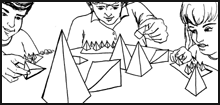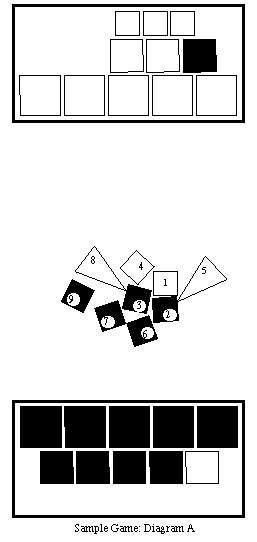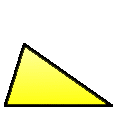 |
|
|
ICEHOUSE SAMPLE GAME
 |
|
|
What follows is a step by step look at a complete game. This sample game includes concrete examples of many rules and strategies that may not be entirely clear after just reading the rules. The final stage of this game serves as a scoring exercise. The correct scores appear at the end of the game notes; we suggest you try counting the score yourself before looking at the answers.
Here's how the notation works: Whenever a piece is played, it is assigned a sequence number. This number indicates the order in which each piece is played, and never changes. If a piece that has already been played is moved, then this change is indicated by adding an extension to its sequence number. Thus, if piece 7 is captured and immediately replayed, it will become 7-2. If it moves again, it will become 7-3. This allows you to track the progress of each piece during the game. The diagrams show the playing field at various stages during the game; the commentary provides an explanation of what happened and why during each maneuver. Also, after the first diagram, all pieces played or moved since the previous diagram are marked with a diamond shaped symbol.
For the sake of clarity, this sample game assigns a different sequence number to each piece, even though in reality two pieces may be played at the exact same time. The commentary will make note of plays that were actually simultaneous.
This game uses standard Icehouse rules, along with the handicap variation. Before the start of the game, each player gave a 2 point pyramid to their opponent.
To really understand what's going on in this example game, you may want to get out your game set and duplicate the sample game in three dimensions, working through each play to see how and why it happened.
This game was created by playing Icehouse on top of a photocopying machine and pressing the "copy" button at various intervals.

[1] Maria plays a small defender.
[2] Torrence plays a small defender.
Note: Plays 1 and 2 were simultaneous.
[3] Torrence plays his second defender, another 1 pointer.
[4] Maria plays her second defender, also another 1 pointer. Both players have now met their meltdown quota.
[5] Maria uses a two point piece to ice piece 2. She's playing offensively. She's currently more concerned with icing her opponent's pieces than with building up her own defenses.
[6] Torrence however is working on a defense. He plays another 1 pointer. His plan is to set up a line of defenders around piece 3, enclosing it in a fortress.
[7] Torrence plays yet another 1 pointer defensively. He's closing the gap. All he needs to do is get one more small piece out there, in the gap between 4 and 7 (the piece he just played) and he'll have piece 3 safe and sound inside a fortress.
[8] Maria, continuing her offensive effort, sees what Torrence is up to and quickly slides piece 8 (a 2 pointer) into position, attacking piece 3.
[9] Torrence is ready with the final piece needed to enclose 3 in a fortress... but he gets there too late. Dazed and confused, he sets the piece out anyway.
 |
 |
 |